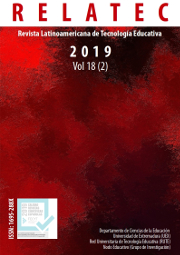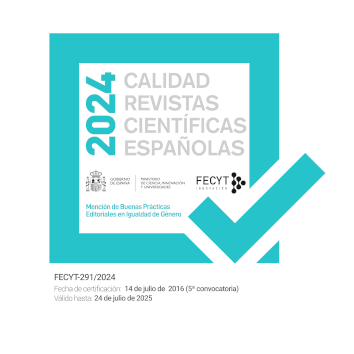Uso de plataformas de video en línea (OVPs) por profesores de música en el diseño didáctico y la práctica educativa
DOI:
https://doi.org/10.17398/1695-288X.18.2.45Palabras clave:
Plataformas de Vídeo en Línea, Youtube, Vídeos en Línea, Aprendizaje multimodal, Tecnología musicalResumen
El desarrollo de las nuevas tecnologías y la popularidad de Internet han transformado nuestras formas de escuchar, hacer y enseñar música. Muchos profesores de música hacen uso de la tecnología en sus clases para enriquecer las experiencias de sus alumnos. Sin embargo, todavía hay pocos estudios sobre el uso de la tecnología en la educación musical, y especialmente el uso de vídeos. En este artículo, discutimos los resultados de un estudio exploratorio sobre el uso de plataformas de video digital como YouTube, Vimeo, Panopto y Dailymotion, por profesores de música estadounidenses en sus clases. A través de una encuesta a 21 maestros, investigamos: (1) la frecuencia del uso de vídeos en la planificación y las clases de música, (2) los tipos de vídeos utilizados por los profesores, (2) las características de los vídeos utilizados en las clases de música; y (4) si hay diferencias en el uso de vídeos en clases de música según el curso y la modalidad (orquesta, banda, coro o musicalización). Los resultados de la encuesta sugieren que los profesores de música usan plataformas de vídeo digital en la planificación y las clases de música, considerando que los vídeos enriquecen la práctica docente y la hace más motivadoras. Las implicaciones para la educación musical se describen al final del artículo.
Descargas
Referencias
Basu, T. (2019, January 15). The science of why «Baby Shark» is so freaking catchy. The Daily Beast. Retrieved from: https://www.thedailybeast.com/the-science-of-why-baby-shark-is-so-freaking-catchy?ref=scroll
Campbell, P. S., Scott-Kassner, C., & Kassner, K. (2017). Music for elementary classroom teachers. New York, NY: W. W. Norton & Company.
Colman, A. (2015). A dictionary of psychology, 4th
Creswell, J. (2017). Educational research. Upper Saddle River, NJ: Pearson.
Dirnhuber, J. (2017, May 2) Children turn backs on traditional careers in favour of internet fame, study finds. The Sun. Retrieved from https://www.thesun.co.uk/news/3617062/children-turn-backs-on-traditional-careers-in-favour-of-internet-fame-study-finds/
Gangnam Style. (n.d.). In Wikipedia. Retrieved October 5, 2019 from https://en.wikipedia.org/wiki/Gangnam_Style
Godinho, J. C. (2016). Miming to recorded music: Multimodality and education. Psychomusicology: Music, Mind, and Brain, 26(2), 189-195.
Ho, W. C. (2004). Use of information technology and music learning in the search for quality education. British Journal of Educational Technology, 35(1), 57-67.
Kruse, N. B., & Veblen, K. K. (2012). Music teaching and learning online: Considering YouTube instructional videos. Journal of Music, Technology & Education, 5(1), 77-87. DOI: 10.1386/jmte.5.1.77_1
Lamont, A. (2002) ‘Musical Identities and the School Environment’, In R.A.R. MacDonald, D.J. Hargreaves and D. Miell (eds.) Musical Identities (pp. 41–59). New York: Oxford University Press.
Lewis, J. (2018). Parents, children, and the popular music that binds them: New family dynamics and what they mean for community music. International Journal of Community Music, 12(1), 79-94.
Love, M.S. (2005). Multimodality of learning through anchored instruction. Journal of Adolescent and Adult Literacy, 48(4), 300-315.
Moore, A.H., Fowler, S.B. & Watson E.C. (2007). Active learning and technology: Designing the change for faculty, students, and institutions. Educause Review, 42(5), 42–61.
Pew Research Center (2018). Teens, social media and technology. Retrieved from: https://www.pewresearch.org/internet/2018/05/31/teens-social-media-technology-2018/
Rudolph, T. E., & Frankel, J. (2009). YouTube in music education. Milwaukee WI: Hal Leonard Corporation.
Salavuo, M. (2008). Social media as an opportunity for pedagogical change in music education. Journal of Music, Technology & Education, 1(2-3), 121-136.
Savage, J. (2007). Reconstructing music education through ICT. Research in Education, 78(1), 65-77.
Smith, H. M. (2011). Global connections via YouTube: Internet video as a teaching and learning tool. In Biamonte, N. (Ed.), Pop-Culture Pedagogy in the Music Classroom: Teaching Tools from American Idol to YouTube (pp. 29-43). Plymouth, England: Scarecrow Press.
Upitis, R., Abrami, P. C., & Boese, K. (2016). The use of digital tools by independent music teachers. In I. A. Sanchez & P. Isais (Eds.), Proceedings of the International Conference on Mobile Learning (pp. 108–112). Vilamoura, PT: International Association for the Development of the Information Society.
Whitaker, J. A., & Orman, E. K. (2014). A content analysis of responses to music teaching videos on YouTube. ISME Commission Research Proceedings, 330.
Yogman, M., Garner, A., Hutchinson, J., Hirsh-Pasek, K., Golinkoff, R.M. (2018, October). The power of play: a pediatric role in enhancing development in young children. Pediatrics, 142(3), 1-16.
YouTube. (n.d). Retrieved October 5, 2019 from https://www.youtube.com/about/press/
Descargas
Publicado
Número
Sección
Licencia
Los autores/as que publiquen en esta revista aceptan las siguientes condiciones:
1. Los autores/as conservan los derechos de autor y ceden a la revista el derecho de la primera publicación, con el trabajo registrado con la licencia Creative Commons Reconocimiento-NoComercial-SinObraDerivada 4.0 International (CC BY-NC-ND), que permite a terceros utilizar lo publicado siempre que mencionen la autoría del trabajo y a la primera publicación en esta revista.
2. Los autores/as pueden realizar otros acuerdos contractuales independientes y adicionales para la distribución no exclusiva de la versión del artículo publicado en esta revista (p. ej., incluirlo en un repositorio institucional o publicarlo en un libro) siempre que indiquen claramente que el trabajo se publicó por primera vez en esta revista.
3. Se permite y recomienda a los autores/as a publicar su trabajo en Internet (por ejemplo en páginas institucionales o personales) antes y durante el proceso de revisión y publicación, ya que puede conducir a intercambios productivos y a una mayor y más rápida difusión del trabajo publicado (vea The Effect of Open Access).









